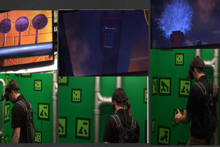Design Interactive
Reconfigurable Vehicle Training System
2nd place - $12,000 Prize
Training system including a virtually reconfigurable vehicle and physical mannequin with environmental factors such as smell, weather, etc.

About the Team
Team members: Zach Huber, Matthew Johnston, Brent Winslow
Design Interactive has been leveraging virtual/augmented/mixed reality and wearable technologies since 1998 to improve the performance of government and commercial enterprise employees. DI specializes in creating biosignatures, wearable ecosystems and advance training solutions. Their mix of human factors, instructional systems design and experts in user experience design, software development, analytics and neuroscience uniquely positions DI to understand and mitigate the root cause of human performance challenges.
Zach Huber, MSc is a Research Associate at DI and graduate of the Ohio State University and manages research and development programs in virtual/augmented/mixed reality and bio-signature development. He managed development of the first true augmented virtuality enterprise training solution, has deployed heads up solutions to industry and successfully created a biosignature of fatigue that can predict future performance from wearables devices.
Dr. Brent Winslow is Chief Scientist at DI and oversees biosignature development and analytics. A graduate of the University of Utah and formerly of the Allen Institute for Brain Science, Dr. Winslow has been instrumental in understanding the stress response of warfighters and first responders. He has over 15 years of experience in studying biological systems and human physiology using quantitative analyses.
Matt Johnston, MSc, Director at DI and graduate of University of Waterloo, directs research and development for commercial enterprise clients in areas of virtual/augmented/mixed reality and bio-signature development. He helps innovative enterprise clients solve organizational performance issues related to the retiring workforce, stress, fatigue and the remote workforce by leveraging the latest wearable and predictive analytic technologies.
The Solution
Zach Huber’s Reconfigurable Vehicle Training System placed a large focus on vehicle based scenarios which are applicable to various public safety professions. Many of the scenarios included in their proposal were practical applications, and good for testing, which include vehicular accidents, routine/unusual traffic stops, and protocols for being the first person on the scene. The idea of the reconfigurable vehicle model is innovative; it allows for training in any kind of personal vehicle (car, SUV or small pickup truck). Larger scenarios, without vehicles (firefighting, building inspection, etc.), could be run by simply pulling the vehicle frame out of the area, and using the environmental factors to create an immersive environment. A modular vehicle model constructed with low-fidelity materials has the potential to provide more diverse scenes. The Project Alloy headset, created by Intel, would allow for the virtual and real worlds to blend together. Project Alloy displays real objects that are within close proximity to the user, while displaying the virtual world everywhere else. Their proposal also included realistic sounds, smells, temperature and weather to improve the immersion for the first responders. These are controlled from a DMX control station that can be run by the trainers, or automated by sensors in the vehicle. This allows the first responder to see their hands and the real tools that they use in real situations, while being immersed in any scenario.

